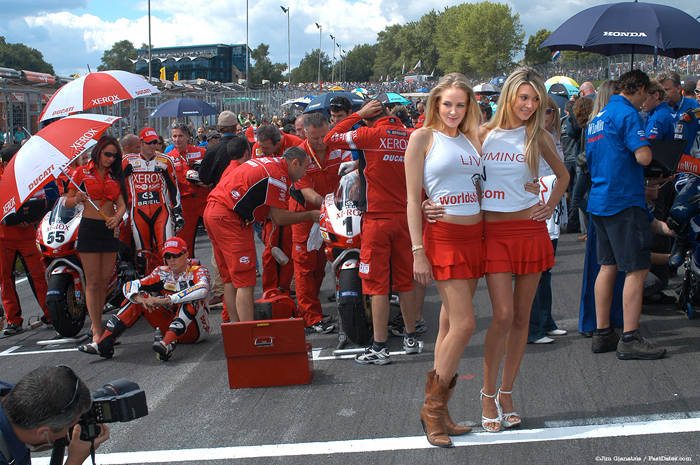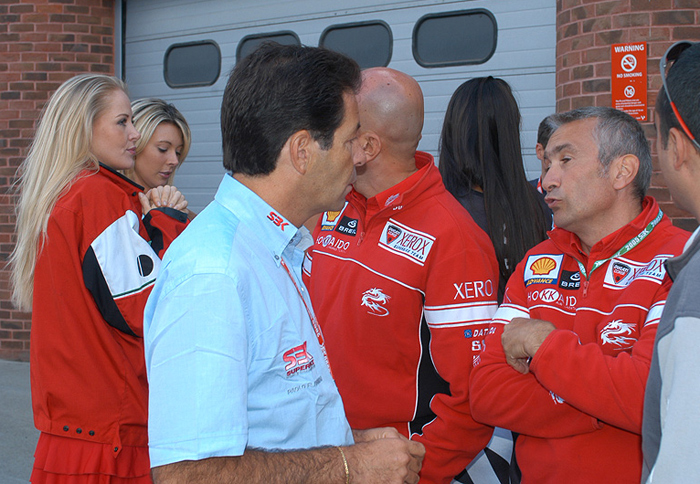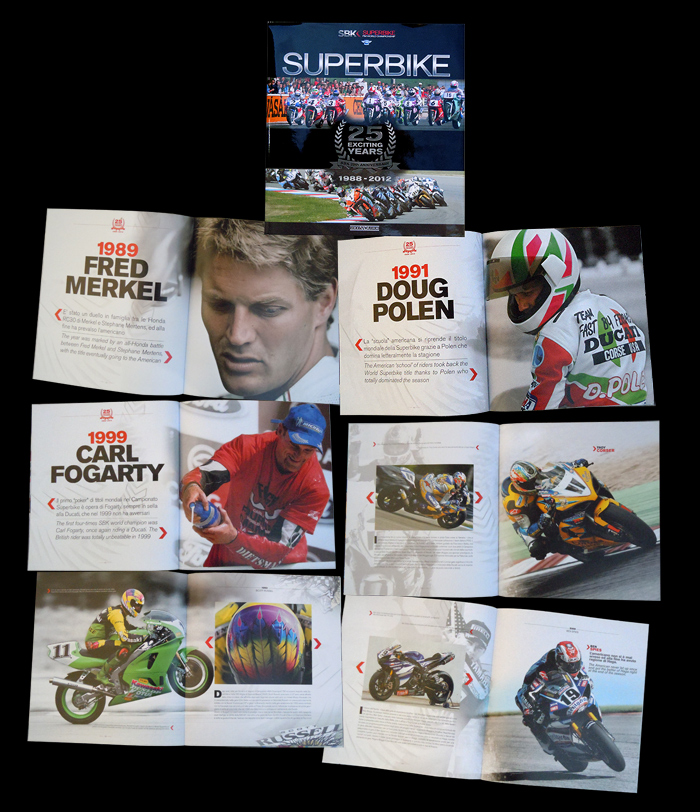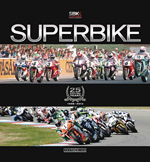World Superbike -The First 25 Years We all received the shocking Press Release back on September 2nd 2012 stating that the private equity firm of Bridgepoint, who already owned the MotoGP World Championship under DORNA, had just purchased the sports marketing firm InFront Sports & Media AG, who had themselves become the owners of the World Superbike Championship a few years earlier. The WSBK was then celebrating its 25th year of under the direction of brothers Maurizio and Paolo Flammini, who stepped in to save the fledgling production bike Championship started by ex-racer American Steve McLaughlin in 1987. We got to know the the very likable Paolo Flammini and his WSBK staff first hand as close friends when World Superbike first came to America and Laguna Seca Raceway, CA, in 1995 with AMA Superbike sharing the weekend, as our annual locale for shooting the Fast Dates Racebike Calendar. Unlike MotoGP which was very restrictive when it came to working with other commercial proprieties, Paolo wanted to work with any company or product like our FastDates.com Calendars who would help to increase the exposure and popularity of World Superbike. And like us, Paolo loved pretty girls, with the official SBK grid girls setting the standard as the prettiest girls on any motorsports grid. At Laguna Seca that year, the four Fast Dates Calendar models I brought up with me from Los Angeles also served as the official WSBK grid and podium girls for the WSBK races, starting a partnership that has lasted to this day.
Running a premier production racing series like World Superbike would always a challenge, especially as the bikes and engines evolved from 1000cc four-cylinders, down to 750cc, then back to 1000cc to reflect what was being sold in the market. And to include the V-twin Ducati bikes which needed a displacement advantage over the Japanese 4- cylinders to stay competitive, with Ducati then dominating because it just spent more money and tired harder than some of the other manufacturers. Then controversies like bringing in Pirelli as the single tire marque, need to reduce costs and keep the teams more equal, prompted manufacturers like Yamaha and Honda (who ran Michelin tires ) to pull out of the Championship in protest for a number of years. Another big controversy came about 4 years ago when the world economic crisis hit and DORNA, with its boss Carmelo Ezpeleta, realized the expensive prototype bikes were no longer affordable for most manufacturers and teams to race. So DORNA lobbied the FIM to allow it to run production streetbike engines in the Moto1 and Moto2 grand prix classes. Because the FIM had previously granted World Superbike an exclusive championship for production motorcycles, Paolo Flammini protested and tried to take legal action against this to protect his Championship. Not cooling down that grudge one degree, but inflaming it even more was the fact in WSBK during the 2011-2012 season, the sophisticated factory superbikes from Ducati Aprilia and BMW were a full 2-seconds a lap quicker than most CRT bikes with similar Aprilia or BMW engines in a prototype chassis. And the top SBK bikes were only 1-second a lap slower on the same track compared to a top factory bikes in MotoGP. If World Superbikes didn't have to run higher minimum weights and engine restrictors like on the Ducati, it was quite possible that production based World Superbikes could and would beat factory prototype MotoGP bikes on the same track on any given day.
Things got even hotter between the two top race Championships when Paolo Flammini held out on requests from MotoGP's organizers to impose further restrictions on development of the WSBK machines. MotoGP wanted to bring the trick factory World Superbikes much more in line with the Superstock-style regulations proposed by FIM to harmonize regulations at the National Championship race levels. Paolo held out with good reason: the racing is better in WSBK, and the manufacturers currently racing in World Superbikes have made it very clear that they have no desire to see any further restrictions on tuning and bike modification put into place. But given WSBK's increasing reliance on manufacturer teams - though blessed with six different manufacturers, the privateer teams without some form of manufacturer backing were finding it increasingly hard to survive. This has lead to shrinking grids in WSBK for 2013 and gaps opening between the factory-backed and privateer squads. Keeping the factories happy is important, but WSBK does at least have the freedom to change the rules without factory interference, something which was until recently unthinkable in MotoGP. A month after the foreboding September 2012 press release from the equity firm Bridgepoint that they now owned both Infront and MotoGP rights owners Dorna, came the announcement they had decided to bring both series under a single umbrella, and that umbrella was to be Dorna, run by Dorna CEO Carmelo Ezpeleta. That news sent a shockwave through the motorcycle racing world. The World Superbike paddock was hit hard, with everyone from Infront staff to team mechanics fearing the outcome of what amounts to a coup by Ezpeleta. Optimists were few, especially as Ezpeleta is one of the most reviled characters among denizens of the WSBK paddock, because of what he represents: the perceived arrogance of the Grand Prix paddock, and a culture which is anathema to everything which World Superbikes stand for.
The only remaining InFront staff that we know of are Christina Siani the long-time Organization Manager who actually runs the races, and Valentina Conti of the SBK Press Office who is keeping their media department going. Whether they survive the transition through 2013 as the Dorna staff learn what they need to know, will have to be seen. Meanwhile, the new boss of the World Superbike Championship is DORNA employee Javier Alonso, who previously ran the DORNA owned Spanish Championship, a local series which hasn't prepared him for the much bigger task of running a World Championship and the diplomacy of dealing with factory teams. Carmelo Ezpeleta, meanwhile, keeps meeting with senior staff from all three Japanese factories looking at competing in the 2014 MotoGP championship about the technical regulations to be introduced from that season onwards. It is believed that Ezpeleta wants a rev limit set at 15,500 RPM and a heavily controlled standard electronics package are to be introduced, whether the factories like the idea or not. This move is necessary both to close the massive performance gap between the factories and the private teams - both satellite and CRT - and reducing the costs in the championship which have spiraled to unsustainable levels. Ezpeleta's message is simple: you are welcome to compete, but you will compete under our regulations, as the regulations which you drew up drove costs completely out of control. There is little about World Superbikes that even needs changing. In contrast to MotoGP, where Bridgestone are supplying tires that are detrimental to the spectacle, Pirelli provide rubber to the teams that allows the riders to put on a real show. The Superpole format works well, especially the twist of only giving riders two sets of qualifiers for three Superpole sessions, and the two-race format on Sunday is a massive hit with motorcycle racing fans. WSBK's only real weakness is an inability to market the series as it could be, and to sell itself short when it comes to TV rights. Several parties have tried to secure rights to supply internet streaming for the World Superbike races, but the current TV contracts make that almost impossible to secure. With better TV coverage and some form of internet streaming of the races, allowing audiences to follow the series in territories where the races are not shown live on TV, these gaping holes could be quickly fixed. What we do wantto do is thank Maurizio and Paolo Flammini, Paolo Ciabatti, Julian Thomas and all our other dear WSBK friends, from all of us in the Media, on the Race Teams and in the Paddock, to the Fans and Sponsors, you will be greatly missed. Thank you for the first 25 years of World Superbike, the greatest motorcycle roadracing championship ever!
And then, just this week, it its first big move in 2013 to dumb down the SBK Championship and reduce costs for the smaller privateer teams, the FIM at DORMA's request has made factory prototype suspension assemblies illegal: FIM Superbike & Supersport World Championship Technical Regulations No aftermarket or prototype electronically-controlled suspension parts may be used, unless such suspension is already present on the production model of the homologated motorcycle, and it must remain completely standard (all mechanical or electronic parts must remain as homologated, with the exception of shims and springs). Editor's Note: This suprise Rule Change taking place immediately, just one race into the 2013 WSBK race season is in direct conflict to a statement Ezpeleta made at a press conference back in October 11th, 2012, where Ezpeleta did his best to first of all quell any fears among the legions of World Superbike fans that Dorna intended implementing any major changes for the coming season, ensuring the assembled media that all would go ahead for 2013 as planned. "For next year things will continue as they are, and both MotoGP and WSBK will continue the same way, with exactly the same system of organization and with the same technical rules," Ezpeleta told the press. "For 2013 the regulations will be the ones that have been approved between the FIM and Infront Motor Sports," he said in response to questions, "In 2013 it will be exactly as proposed by the different parties involved, there will not be any changes for 2013." Obviously Zzpeleta did not keep his word. But in fact, this is actually a very good rule as it will considerably reduce race bike costs in Superbike and Supersport, by as much as $30,000 US per motorcycle. Last season 2012, the new Ducati 1199 Panigale S could not race in Superstock with its production based electronic suspension, but had to have mechanically adjusted valving installed, since electronic suspension has been illegal until now in FIM roadracing to eliminate the cost of the very expensive prototype electronic suspensions first introduced some 8 years ago in MotoGP racing. But now that production bikes are coming stock with electronic suspension like the Ducati 1199S, BMW HP4 and Aprilia RSV4, it was actually costing a huge about of money more to convert them back to non electronic damping shocks and forks to race in both the Superbike and Supersport classes. In the Superbike class, the Ohlins factory TTX resevoirs forks cost some $12,000 plus necessary larger diameter adjustable triple clamps, steering dampers and mounts, brake, axle, fender fittings, et all - you might be looking at close to $20,000 just for a complete front fork assembly.
New 3 Mechanic Pit Stop Rule in World Superbike for 2013
World Superbike - 25 Exciting Years Included in the book is this forward from Maurizio and Paolo Flammini, which we have taken the liberty to except here, as a tribute to them and their 25 years in the Championship with they made the best in the World! "Finding ourselves today celebrating this achievement, makes us feel very close to those riders who take the checkered flag after a thrilling race fought out at the limit of their physical and mental prowess. Joy over having achieved this particular goal is immediately followed by thoughts of the next challenge. Dreams, speed, engine noise, passion, risks, hard work, competition, disappointment and joy, are are elements that make up the heart and soul of our world and unite us all, whether we are organizers, engineers, riders, journalists, sponsors or fans. And it is certainly thanks to the pathos and that co-existance of all these elements has created in our minds, that we have been able to find the motivation to transform a dream into a splendid reality. Today the World Superbike Championship is one of the greatest events in the international sporting calendar. The scene of the battle for the best riders and most important motorcycle manufacturers, and exciting product for the National and International media and a thrilling sporting saga fro fans throughout the world, a young adult called the World Superbike Championship is today now fully grown up! Both of us have made this project raison d'etre in our lives and we have spent all of our best energies to ensure the Superbike World Championship can find a consolidated and successful space in the panorama of world sport. We have however not traveled this path alone. Above all, we must mention our partner since the very beginning - the FIM - with whom we have shred every day of the life of our Championship. Secondly, all of our collaborators, whose passion, professionalism, and dedication have made up and continue to make up a fine example that is recognized throughout the world and who together with us have worked hard, suffered and rejoiced in reaching our goals. And since 2007, InFront Sports & Media, a world leader in the sports marketing spectrum who have provided our company and the World Superbike Championship with a further boost in development and professionalism. But we must not forget either all the other protagonists in this splendid 'circus'. The riders, the manufacturers, the teams, the sponsors, the media, the circuit representatives, the fans. It is thanks to the joint efforts of everyone that in just a relatively short period of time, the Superbike World Championship has become a great show and an important business engine. But for all of us the challenge continues, there are many more checkered flags waiting to be conquered...." - Paolo and Maurizio Flammini
|
The Official SBK The Official SBK Received in an Email
|








